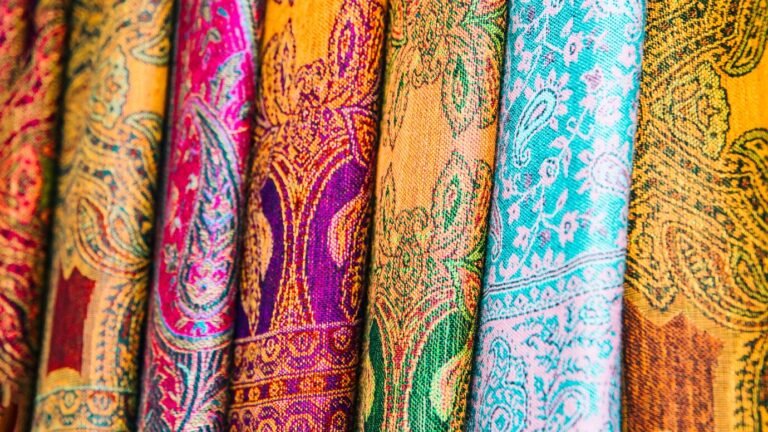India, a land of vibrant cultures and ancient traditions, is globally renowned for its diverse textile heritage. From intricate weaves to luxurious silks, India’s fabric types are deeply rooted in the country’s history, geography, and artistry. This article explores the unique characteristics, origins, and applications of various India Fabric Types a deeper understanding of their enduring appeal.
Cotton: The Fabric of Comfort
Cotton is one of the oldest fabrics produced in India, celebrated for its versatility and breathability. Indian cotton fabrics are not only comfortable but also available in numerous regional varieties that reflect the country’s cultural diversity.
Notable Cotton Fabrics:
Khadi: Hand-spun and handwoven, Khadi symbolizes India’s freedom movement and promotes sustainable fashion. Its coarse yet durable texture makes it suitable for both summer and winter wear.
Madras Cotton: Known for its vibrant patterns, Madras cotton from Tamil Nadu is a lightweight fabric popular in shirts, dresses, and casual wear.
Muslin: Originating in Bengal, Muslin is an ultra-fine cotton fabric once reserved for royalty. Today, it’s widely used for scarves, dresses, and baby garments due to its softness.
Silk: The Queen of Fabrics
India is one of the largest producers of silk globally, offering a wide range of silk varieties. Its natural sheen, durability, and elegance make it a favorite for traditional and festive attire.
Prominent Silk Varieties:
Banarasi Silk: This luxurious silk from Varanasi features intricate brocade patterns with gold and silver threads, often used in bridal sarees and festive wear.
Mysore Silk: Known for its purity and simplicity, Mysore silk is ideal for sarees and traditional outfits.
Tussar Silk: With a natural golden hue, Tussar silk from Bihar is widely used for sarees, stoles, and home furnishings.
Linen: Crisp and Elegant
Derived from flax fibers, linen is lightweight, strong, and highly absorbent, making it an ideal fabric for India’s tropical climate. Linen garments, especially shirts, sarees, and trousers, are preferred for their cool and crisp appearance.
Wool: Warmth and Luxury
Indian woolen fabrics are predominantly crafted in northern regions like Kashmir and Himachal Pradesh, where colder climates demand warm clothing.
Popular Woolen Fabrics:
Pashmina: Known as “soft gold,” Pashmina wool from Kashmir is hand-spun and woven into exquisite shawls and scarves. It is highly valued for its softness and warmth.
Kullu Shawls: These vibrant shawls from Himachal Pradesh feature intricate geometric patterns and are perfect for winter wear.
Jute: The Golden Fiber
Jute is a biodegradable and eco-friendly fabric grown primarily in West Bengal. Often referred to as the “Golden Fiber,” jute is durable and widely used in creating bags, rugs, and home décor items. Its rustic charm makes it a sustainable choice for modern consumers.
Georgette: Light and Elegant
Georgette is a sheer, lightweight fabric made from silk or synthetic fibers. Known for its crinkled texture and fluid drape, it is a popular choice for sarees, dresses, and blouses. Georgette’s versatility allows it to transition seamlessly from casual wear to party attire.\\
Chiffon: Soft and Flowing
Similar to georgette, chiffon is a lightweight fabric prized for its smooth, flowing texture. Its translucent quality makes it ideal for evening gowns, sarees, and scarves, adding sophistication to any outfit.
Brocade: Ornate and Opulent
Brocade is a richly decorative fabric woven with gold or silver threads, often featuring floral and geometric patterns. Commonly used in bridal attire and upholstery, brocade reflects India’s tradition of grandeur and elegance.
Organza: Sheer and Glossy
Organza, traditionally made from silk, is a sheer fabric known for its crisp texture. Often used in evening wear, sarees, and decorative items, organza adds a touch of sophistication and glamour.
Denim: Modern Meets Traditional
Though not a traditional fabric, denim has found its place in Indian fashion. Indian artisans have started incorporating traditional embroidery and patterns into denim clothing, creating a fusion of contemporary and ethnic styles.
Handloom Fabrics: A Legacy of Artisanship
Handloom fabrics are an integral part of India’s textile identity, showcasing the craftsmanship of local weavers. Some notable examples include:
Ikat: Known for its tie-dye technique, Ikat fabric is produced in regions like Odisha, Andhra Pradesh, and Gujarat.
Kalamkari: This hand-painted or block-printed fabric is characterized by intricate motifs and natural dyes.
Chanderi: A blend of silk and cotton, Chanderi fabrics from Madhya Pradesh are lightweight and adorned with traditional zari work.
Comparison Chart of Indian Fabric Types
| Fabric Type | Origin/Region | Key Characteristics | Common Uses |
| Khadi | Nationwide | Hand-spun, eco-friendly | Casual wear, home décor |
| Banarasi Silk | Varanasi, Uttar Pradesh | Luxurious, intricate brocade patterns | Bridal sarees, festive wear |
| Mysore Silk | Karnataka | Minimalistic design, pure silk | Sarees, traditional attire |
| Tussar Silk | Bihar | Rich texture, natural golden hue | Sarees, stoles, furnishings |
| Muslin | Bengal | Soft, delicate | Scarves, dresses, baby garments |
| Pashmina | Kashmir | Ultra-soft cashmere wool | Shawls, scarves |
| Jute | West Bengal | Durable, eco-friendly | Bags, rugs, home décor |
| Brocade | Nationwide | Decorative, opulent patterns | Bridal wear, upholstery |
| Organza | Nationwide | Sheer, crisp texture | Evening wear, decorations |
| Chanderi | Madhya Pradesh | Lightweight, zari work | Sarees, salwar suits |
Adapting to Google’s November 2024 Core Update
To optimize content post-Google’s latest core update, it’s crucial to:
Focus on original, user-centric content that satisfies search intent.
Prioritize mobile-friendly designs and fast-loading pages to enhance user experience.
Incorporate E-E-A-T principles: Experience, Expertise, Authoritativeness, and Trustworthiness.
Conclusion
India’s fabric heritage is a vibrant tapestry of traditional craftsmanship and modern innovation. From the luxurious silk of Banaras to the eco-friendly jute of Bengal, these fabrics embody the country’s diverse culture and artistry. Exploring these textiles not only celebrates India’s rich history but also inspires sustainable and ethical fashion choices for the future. Whether you’re a fashion enthusiast or a casual shopper, understanding India’s fabric types will deepen your appreciation for this timeless art form.

